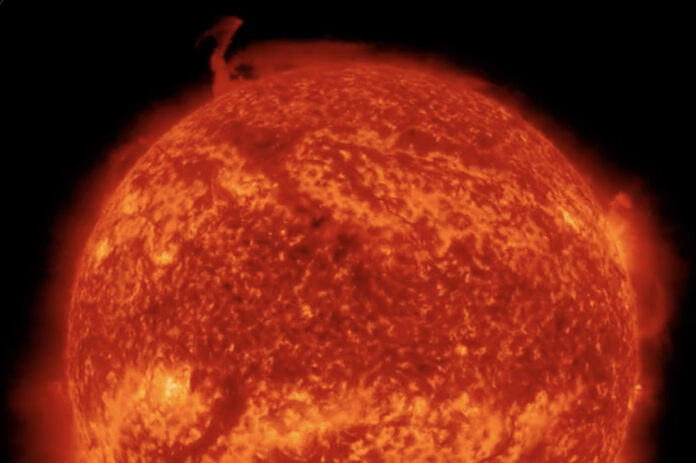
Multiple outbursts from the sun could trigger magnificent auroras in many parts of the United States this weekend.
A severe geomagnetic storm is expected to hit Earth on Friday, triggering colorful nighttime auroras, or the northern lights. People in the United States could see moderate to strong geomagnetic activity starting around 11 p.m. and lasting through Saturday.
Current forecasts project the lights could be seen as far south as Alabama and California, according to the National Oceanic and Atmospheric Administration’s Space Weather Prediction Center. Chances of seeing the lights will be highest in the northern United States, Canada and northern Europe.
To maximize your chances of seeing auroras Friday night, find a dark sky location away from city lights. You’ll also want cloud-free skies. Unfortunately, considerable cloud cover will be spread over the Great Lakes, Mid-Atlantic and Northeast, although some gaps in the cloud canopy are probable. Clear skies are most likely over the central states and West Coast.
Geomagnetic storms are hard to forecast, and sometimes predicted northern lights displays disappoint if a storm’s timing changes or its magnetic field is out of alignment with the Earth’s.
“It is a rather volatile situation on the sun right now that we’re monitoring very closely,” said Bill Murtagh, program coordinator at NOAA’s Space Weather Prediction Center. “We’re going to get somewhat of a prolonged period of geomagnetic storming.”
The geomagnetic storm comes when the sun is at its most active in about two decades, and it is expected to remain so for at least the rest of this year.
Auroras are created when energy and particles from the sun temporarily disturb Earth’s magnetosphere, creating a geomagnetic storm. Some solar particles travel along our planet’s magnetic field lines into the upper atmosphere, exciting nitrogen and oxygen molecules and releasing photons of light in different colors.
Friday’s anticipated geomagnetic storm is the result of multiple explosions on the sun, called coronal mass ejections. Coronal mass ejections are large clouds of solar plasma and magnetic field. Starting earlier this week, the sun has sent at least four to five of these eruptions toward Earth that are expected to first arrive Friday. It’s possible that some of these ejections will combine – increasing the magnitude of the storm.
“Depending on how these [coronal mass ejections] are staggered, you can expect the activity to last longer,” said Rob Steenburgh, a space scientist at NOAA’s Space Weather Prediction Center. “Our expectation and the modeling do suggest that they kind of catch up with each other.”
As of Thursday afternoon, NOAA forecasts predicted a severe geomagnetic storm, rated 4 out of 5. If the geomagnetic storm is that strong, people in southern states might be able to see a red glow, as has happened in recent storms of similar strength.
Intense geomagnetic storms can also sometimes disrupt power systems, GPS communications or satellite operations. Steenburgh, though, doesn’t anticipate issues with power systems and is working closely with grid operators across North America ahead of the storm.
The coronal mass ejections came from a particularly bustling area in the southwestern hemisphere of the sun, labeled active region 3664, Steenburgh said. Active regions are easy to see because they contain dark areas called sunspots. Sunspots are temporary dark blotches where the sun’s magnetic field is extremely strong, eventually breaking through the sun’s surface.
“These sunspot clusters emerge, and we see hundreds of them a year. But very few of them reach this size and magnetic complexity,” Murtagh said. “What makes it unique here is just that it is so magnetically stressed and magnetically complex.”
The same sunspot group also released intense bursts of radiation known as solar flares. The sun unleashed three X-class flares – the most intense kind – since Wednesday. Solar flares can disrupt radio communications, although Murtagh said NOAA officials haven’t received any such reports yet.
The size of the sunspot group is actually on par with that of the 1859 Carrington event, dubbed one of the most intense solar storms to hit Earth, but Murtagh said this incoming geomagnetic storm will not be close to the same level of the Carrington storm.
If you still have your solar eclipse glasses, you can spot the large dark blotches on the lower right quadrant of the sun.
If you miss a good light show Friday night, keep alert over the weekend, Murtagh and Steenburgh said. The sunspot group appears to remain active and could send more coronal mass ejections toward Earth before it rotates away from our path.
“Because that region has been active and has a history of producing these, it would not be out of the question to potentially have another chance,” Steenburgh said. “I tell people to just stay tuned over the weekend and keep an eye on things.”
(c) Washington Post











